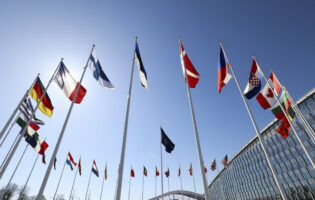Proper Remembrance – The Most Essential for Reconciliation
Three Types of International Reconciliation
Even after forty years, the image of former German Chancellor Willy Brandt kneeling down at the monument to the victims of the 1943 Warsaw Ghetto Uprising still serves as a symbol of Germany’s repentance and reconciliation with Poland. Reconciliation between nations is not always so obvious or moving, however. Whether true reconciliation has been accomplished is determined differently according to the observer, and this fact accounts for the continued controversies frequently seen among Northeast Asian countries. Everyone knows what the term “reconciliation” means, but few can provide a proper answer to the question, “Have Korea and Japan achieved reconciliation?” This irony arises partly from the conceptual definition of “reconciliation,” but it also springs from considering reconciliation to be a single fixed state.
International reconciliation is the “international process of resolving and overcoming problems generated by hostile acts committed between countries.”[1] It refers to the process of confronting and solving physical and emotional issues generated during past periods of colonial rule or war. Given that reconciliation is a “process,” it is impossible to explain certain aspects of reconciliation if it is viewed as a fixed state. Just as international relations are not static but rather marked by dynamic ties that are subject to change, international reconciliation can also take various forms at different times. It can be classified into three types: Procedural, Substantial, and Ideational reconciliation. Procedural reconciliation refers to the institutional recovery of relations, such as the normalization of diplomatic relations; Substantial reconciliation refers to the economic restoration of relations, such as provision of war indemnity or individual compensation; Ideational reconciliation refers to the psychological restoration of relations based on shared historical understanding and mutual trust.[2]
Procedural reconciliation is the most common form of reconciliation achieved between countries, while ideational reconciliation is difficult to accomplish as it requires thorough reflection on the part of the assailant country. All three types of reconciliation are theoretical and ideal, and they are transformed according to various circumstances in reality. The Germany-Poland case is an example in which both procedural and substantial reconciliation are achieved; it can thus be evaluated as the closest case of ideational reconciliation. Reconciliation was achieved because Germany repented for its past action completely and remembered what it afflicted on Poland. However, in the case of the Korea-Japan relationship (the most controversial relationship in Northeast Asia), on which this essay will focus, the subjects of Japanese commemoration and the methods used by Japan in remembering are inappropriate. This essay will reveal the problems Japan faces, and explain what is required in order to achieve ideational reconciliation in the Korea-Japan relationship.
Troubled Reconciliation between Korea-Japan
The first step of procedural reconciliation was taken by Korea and Japan with the signing of the San Francisco Peace Treaty after the war. This treaty enabled Korea, then occupied by Japan, to achieve independence. However, unable to officially participate in the peace treaty, Korea had to discuss separately the issue of Japan’s responsibility and compensation for its colonial rule. As a result, after many summits held over fourteen years, the Treaty on Basic Relations between Japan and the Republic of Korea was signed in 1965 to normalize diplomatic relations between the two countries. During this time, the “agreement on claim and economic cooperation” was signed to provide $300 million compensation, a loan of $200 million, and private credit worth $300 million.[3] Furthermore, Japan also established the Asian Women’s Fund in 1995 based on private funds collected to compensate for the “Japanese army’s comfort women” and government funding for medical welfare. Formed through public fundraising, the Asian Women’s Fund decided to provide each person with $20,000 as compensation. Also, the Japanese government decided to provide $30,000 in medical welfare along with an apology letter from Japan’s prime minister. However, most of the “comfort women” of Korea rejected the compensation, criticizing the act as a political performance not accompanied by willingness in Japan to take legal responsibility or make apologies. The compensation for colonial rule was a sensitive issue that exerted significant influence and aroused strong reactions in domestic politics, including opposition from conservatives in both countries.
Despite criticism from elements of Korean society, it cannot be said that Japan has been altogether negligent in providing material and economic compensation. Korea and Japan have failed to achieve absolute reconciliation due to psychological, rather than economic, disagreements. The main reason that Korea and Korean victims refuse to reconcile with Japan has to do with the subjects that Japan commemorates.
Whom does Japan commemorate?
To Japan, August 1 is a day of defeat. To the Japanese who commemorate this day, the people who became victims in the Asia-Pacific nations hold only secondary significance or are simply not considered. Every year on August 15, Japan’s emperor, prime minister, cabinet members, and thousands of bereaved family members participate in the “event for honoring the war dead and praying for peace,” held in Budokan, Japan. However, the memorial tributes held on this day are restricted to Japanese soldiers or the military. The officially announced subjects of the memorial tributes are “persons that died during war after the Sino-Japanese War (including soldiers, paramilitary soldiers, those that died in other areas, and those that died within the region).” In this regard, the event is restricted to domestic rituals. The event commemorates a total of 3.1 million people, comprised of 2.3 million soldiers who passed away during the war, 30,000 civilians who died overseas, and 500,000 people who died in Japan due to the air raids by the U.S. army. It is difficult to find articles in Japan’s major newspapers that emphasize the need to be considerate of foreign countries. Japan does not mention its past harmful acts, let alone apologize or reflect on the crimes the state committed in Korea, China, and Southeast Asian nations.
Japan speaks of the soldiers killed in the war, remembers only the deaths incurred domestically, and regards itself as a victim. As a whole, the nation has forgotten about the aggressive war it launched on weaker nations and the countless victims of its war crimes.
The prerequisites that Korea has identified for achieving reconciliation with Japan center on Japanese acknowledgement of its responsibility and sincerely repent for the harm it caused to Korean victims. But Japan does not even acknowledge the existence of Korean victims, such as forced laborers and “comfort women,” let alone cherish them and repent for their wrongdoings. Even after suffering extreme physical and psychological damage, Korean victims are forced to endure the added pain of being forgotten by the nation that harmed them.
What does Japan remember?
Even before its defeat in the war, Japan made efforts to establish war museums to glorify its acts and honor its dead soldiers. The construction of such museums was supported by the military and local public organizations in the name of mobilizing the public for war purposes and promoting military education. Although most of these museums were closed after Japan’s defeat, they were revived a decade later in the name of “peace.” Museums memorializing the atomic bombs and Okinawa air raid were formed immediately after Japan’s defeat, and museums stressing the tragedy of war and significance of peace were built in each region. However, these peace museums, also called peace memorial halls, were constructed not to remember the war started by Japan, but rather to remember the injuries the nation sustained through the war.
Japan’s war memories are well depicted in the Hiroshima Peace Center, which provides explanations on the commemorated facilities along with information on the 1931 Manchuria incident and the surprise attack on the U.S. naval base at Pearl Harbor. The decisive incident and principal agent have been modified and neutralized in these explanations. For example, the cause given for armed clashes is an “uncertain event.” This, in turn, grants amnesty to the Japanese government, military, and people for their involvement in the war and colonial rule. In particular, the atomic bomb that landed on Hiroshima becomes a symbol of tragedy and the pain experienced by the Japanese. By emphasizing the memory of students sacrificed in the Hiroshima attack and Okinawa battle, the people of Japan are wrongfully remembered as victims of war. Awareness, in turn, is reduced regarding the harm Japan inflicted upon its surrounding nations.
How does Japan remember?
On 4 August 2000, a war memorial in the Ishikawa shrine for deceased patriots was established, inscribed with the words “holy war to create a greater East Asia.” According to this memorial, the war started by Japan can be described as a “holy war” in that the Asia-Pacific war “liberated” Asia from the colonial rule of the West. This notion is also reflected in information provided by the Foreign Office of Japan on colonial rule, which argues: “Japan’s rule over Korea was by no means colonial exploitation. Korea achieved modernization and improvement in economic, social, cultural aspects due to Japan’s contribution.”[4] This is also called the “theory of colonial modernization.” Furthermore, Japan believes that the colonial exploitation was “not an illegal act as the nation was acquired through methods acknowledged as normal according to the international customs of the time.”[5] In other words, Japan’s rule over the Korean Peninsula was not intentionally pursued by the nation, but rather resulted from the “historic dynamism” of East Asia after the late nineteenth century combined with Korea’s “lack of self-governance ability.” Japan argues that at the end of the nineteenth century, the Korean Peninsula was a volatile region with unstable political circumstances and without the will or power to acquire independence. Seeing this, Japan carried out the Russo-Japanese/Sino-Japanese Wars at the expense of Japanese people in order to protect both their own state and the Korean Peninsula. Japan thus argues that its colonial rule was legitimate, not marked by exploitation or violence, and ultimately beneficial to Korea’s development.
Japan does not remember the invasion that accompanied its colonial rule of Korea, nor does it remember the harm it inflicted by using violence, exploitation, and plunder to suppress resistance. Rather, Japan beautifies its national image as a “savior” or “hero” that rescued Korea from Western nations at the expense of many Japanese lives. It denies the historical truth, striving to memorialize only what reflects positively on Japan. The responsibility for the war and postwar damages does not exist in the Japanese memory.
Proper Remembrance is What Korea Most Wishes
The relationship between Korea and Japan improves and breaks down according to various situations and issues. This is partially due to the dynamic geopolitical system and the changeability of international relations. However, the relationship between Korea and Japan reveals a particular structural defect that leads the two nations to immediately turn their backs to one another whenever a slightly sensitive issue appears. Japan believes that it has sufficiently compensated and apologized for the harm inflicted upon Korea. However, Korea refuses to accept Japan’s apologies, complaining of the nation’s insincerity. Who is to blame in this situation? The reason Korea and Japan have been repeatedly caught in this vicious cycle is that, unlike Germany and Poland, they have not achieved ideational reconciliation. Japan’s method of substantial reconciliation, which leads the Japanese to believe that they have made sufficient efforts to reconcile with Korea, prevents Japan from understanding the desires of Koreans. On the other hand, Korea cannot achieve a more mature form of reconciliation if it merely criticizes Japan without clearly expressing its desires.
What Korea and Korean victims want most from Japan is for the Japanese to acknowledge and properly remember the fact that they harmed and defiled Koreans during the war. The “comfort women,” who have refused to accept compensation from Japan, request the same. They do not need money; they need recognition of the injustice they experienced. The victims of colonial rule and war have already passed away or are old men and women in their seventies and eighties. These victims want to regain their honor and recover their rights that have not been acknowledged in the past. Japan probably knows this already but is unable to take action due to its international reputation and responsibility. However, Japan must remember that Germany’s sincere recognition and apology contributed to the increase in its international status and reputation.
Now is the time for Japan to have some courage. True maturity is achieved not in remembering one’s own pain, but in recognizing when one has harmed others. In order for Japan to fulfill its responsibility as a mature state, it must properly remember the victims of Korea. When this happens, Korea must not distort Japan’s intention by viewing it as political rhetoric, but rather accept the nation’s apology. The victim, too, is obligated to accept sincere conciliatory gestures offered by the assailant.
Dr. Ja-Hyun Chun is a researcher at Yonsei University and will be a Visiting Fellow at AGI from November 2012-January 2013, where she will work on relations between Germany-Poland and Japan-South Korea.
[1] Ja-Hyun Chun, “Politics of International Reconciliation,” Doctoral Dissertation (2012), 2-3.
[2] France-Algeria and U.S-Vietnam are examples of Procedural reconciliation, Japan-Korea and Japan-China are examples of Substantial reconciliation, and Germany-Poland is an example of Ideational reconciliation. See also Ja-Hyun Chun, 2012.
[3] Japan emphasized the significance of economic cooperation without indicating its responsibility and recognition of its colonial rule, drawing opposition from the Korean government and public.
[4] Ministry of Foreign Affairs of Japan, Micro Film the 7th Public Release, p. 742.
[5] Nisio Ganji, The History of Nation (1999): 523-534.









